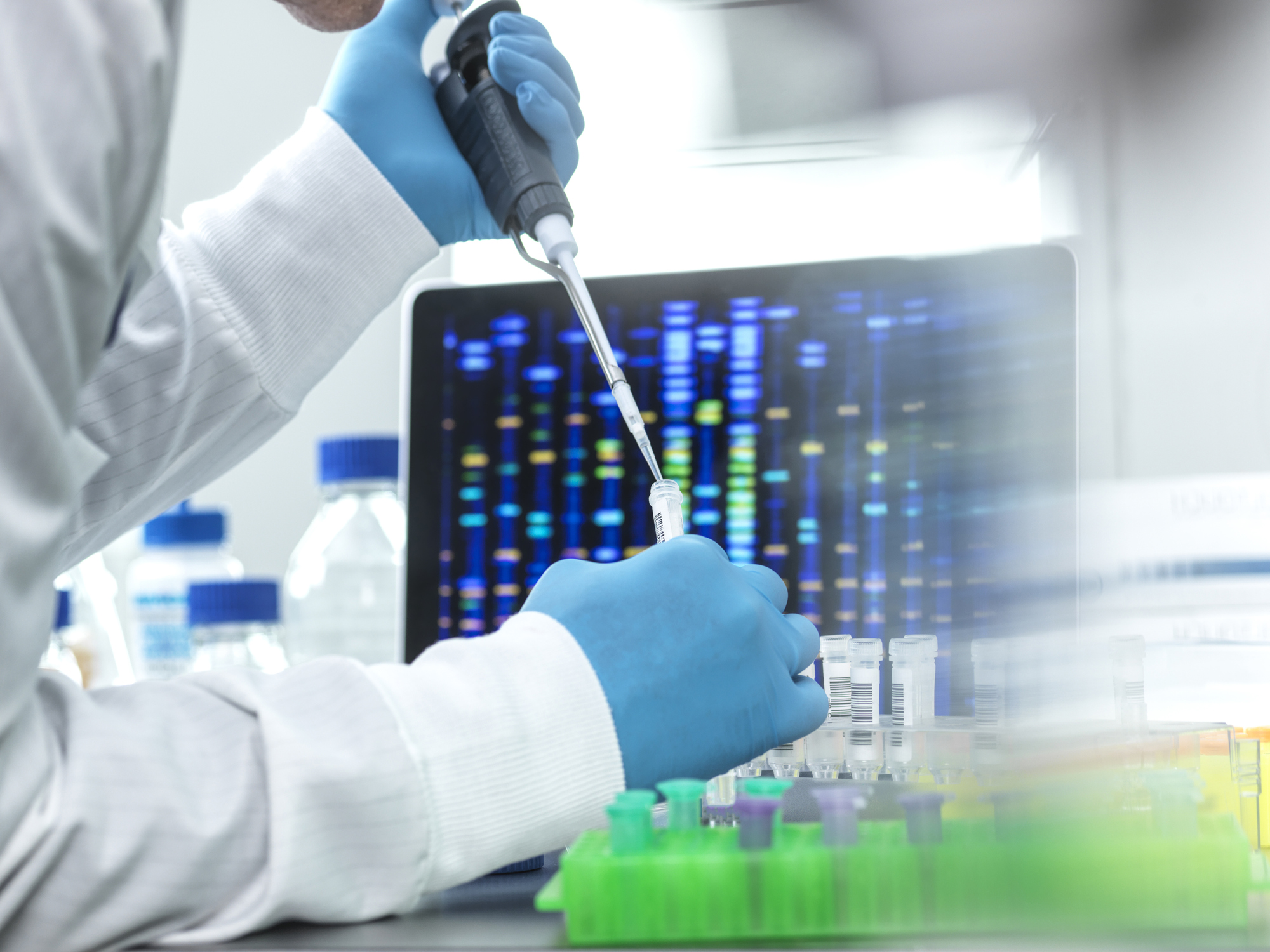For childhood cancer survivors, inherited genetic factors influence risk of cancers later in life
For childhood cancer survivors, inherited genetic factors influence risk of cancers later in life National Institutes of Health (NIH) (.gov)



NIH-led study sheds light on the causes of new cancers among childhood cancer survivors and could have implications for their screening and follow-up
News Release
Thursday, March 7, 2024
Introduction
Common inherited genetic factors that predict cancer risk in the general population may also predict elevated risk of new cancers among childhood cancer survivors, according to a study led by researchers at the National Cancer Institute (NCI), part of the National Institutes of Health. The findings, published in Nature Medicine, provide additional evidence that genetics may play an important role in the development of subsequent cancers in survivors of childhood cancer and suggest that common inherited variants could potentially inform screening and long-term follow-up of those at greatest risk.
Background
Childhood cancer survivors are known to have a higher risk of developing a new cancer later in life due to adverse effects of cancer treatment or rare inherited genetic factors. In the new study, the researchers evaluated the combined effect of common variants with a history of radiation treatment and found that the resulting elevated cancer risk was greater than the sum of the individual associations for treatment and genetic factors alone.
Implications for Screening and Follow-up
“Knowledge about a person’s genetic makeup could potentially be useful in managing their risk of subsequent cancers,” said lead investigator Todd M. Gibson, Ph.D., of NCI’s Division of Cancer Epidemiology and Genetics. “The hope would be that, in the future, we can incorporate genetics along with treatment exposures and other risk factors to provide a more complete picture of a survivor’s risk of subsequent cancers to help guide their long-term follow-up care.”
Polygenic Risk Scores
To assess the contribution of common inherited genetic variants to the risk of subsequent cancer in people who survived childhood cancer, the research team used data from genome-wide association studies (GWAS) conducted in large populations of healthy individuals. These studies have identified thousands of common inherited variants associated with the risk of different cancers. The risk associated with a single common variant is typically small, but the effects of large numbers of variants can be bundled into a summary score, or polygenic risk score, that provides a more comprehensive estimate of someone’s genetic risk.
Association between Polygenic Risk Scores and Cancer Risk
Although polygenic risk scores have shown promise for predicting cancer risk in the general population, it has not been known whether such scores are also associated with the risk of subsequent cancer among childhood cancer survivors.
To find out, the researchers looked at the association between polygenic risk scores and the risk of basal cell carcinoma, female breast cancer, thyroid cancer, squamous cell carcinoma, melanoma, and colorectal cancer among 11,220 childhood cancer survivors from two large cohort studies. For all of these cancers except colorectal cancer, polygenic risk scores derived from GWAS in the general population were associated with the risk of these same cancers among childhood cancer survivors.
Joint Effect of Polygenic Risk Score and Treatment History
The researchers then looked at basal cell carcinoma, breast cancer, and thyroid cancer — malignancies that occurred most often in the combined dataset and that are strongly linked to radiation therapy — to examine the joint effect of polygenic risk score and treatment history. They found that the risk associated with the combination of higher-dose radiation exposure and a higher polygenic risk score was greater than would be expected based on simply adding the risk associations of each individual risk factor.
For basal cell carcinoma, a high polygenic risk score was associated with a 2.7-fold increased risk compared with a low polygenic risk score among survivors. A history of higher radiation exposure to the skin was associated with a 12-fold increase in risk, compared with lower radiation exposure to the skin. However, survivors with high polygenic risk scores and higher doses of radiation to the skin had an 18.3-fold increased risk of basal cell carcinoma, compared with those with low polygenic risk scores who had received lower radiation doses to the skin.
Moreover, by age 50, survivors with higher polygenic risk scores and higher radiation exposure had a greater cumulative incidence of basal cell carcinoma, breast cancer, or thyroid cancer than those with lower polygenic risk scores or lower radiation exposure. For example, among female survivors who had radiation to the chest, 33.9% of those with a high polygenic risk score had been diagnosed with breast cancer by age 50, compared with 21.4% of those with a low polygenic risk score.
Limitations and Future Directions
One limitation of the study is that the populations included in the analysis were predominantly of European ancestry, so additional studies are needed in diverse populations. Furthermore, polygenic risk scores are not yet used routinely in the clinic, although they may one day inform screening approaches or other clinical decisions.
“Although these results suggest that polygenic risk scores could play a role in improving guidelines for long-term follow-up of childhood cancer survivors exposed to radiation, right now they are not sufficient on their own to alter existing guidelines,” Dr. Gibson noted.
About the National Cancer Institute (NCI)
NCI leads the National Cancer Program and NIH’s efforts to dramatically reduce the prevalence of cancer and improve the lives of people with cancer. NCI supports a wide range of cancer research and training extramurally through grants and contracts. NCI’s intramural research program conducts innovative, transdisciplinary basic, translational, clinical, and epidemiological research on the causes of cancer, avenues for prevention, risk prediction, early detection, and treatment, including research at the NIH Clinical Center—the world’s largest research hospital. Learn more about the intramural research done in NCI’s Division of Cancer Epidemiology and Genetics. For more information about cancer, please visit the NCI website at cancer.gov or call NCI’s contact center at 1-800-4-CANCER (1-800-422-6237).
About the National Institutes of Health (NIH)
NIH, the nation’s medical research agency, includes 27 Institutes and Centers and is a component of the U.S. Department of Health and Human Services. NIH is the primary federal agency conducting and supporting basic, clinical, and translational medical research, and is investigating the causes, treatments, and cures for both common and rare diseases. For more information
SDGs, Targets, and Indicators
1. Which SDGs are addressed or connected to the issues highlighted in the article?
- SDG 3: Good Health and Well-being
- SDG 10: Reduced Inequalities
The article discusses the increased risk of new cancers among childhood cancer survivors and the potential use of genetic factors in managing their risk. This aligns with SDG 3, which aims to ensure healthy lives and promote well-being for all at all ages. Additionally, the article mentions the need for additional studies in diverse populations, indicating a concern for reduced inequalities (SDG 10) in healthcare.
2. What specific targets under those SDGs can be identified based on the article’s content?
- SDG 3.4: By 2030, reduce by one-third premature mortality from non-communicable diseases through prevention and treatment and promote mental health and well-being.
- SDG 10.2: By 2030, empower and promote the social, economic, and political inclusion of all, irrespective of age, sex, disability, race, ethnicity, origin, religion or economic or other status.
The article highlights the need to manage the risk of subsequent cancers among childhood cancer survivors, which relates to SDG 3.4’s target of reducing premature mortality from non-communicable diseases. Additionally, the mention of diverse populations indicates a concern for inclusivity and reducing inequalities in healthcare, aligning with SDG 10.2.
3. Are there any indicators mentioned or implied in the article that can be used to measure progress towards the identified targets?
- Indicator for SDG 3.4: Prevalence of cancer among childhood cancer survivors and the effectiveness of genetic factors in managing their risk.
- Indicator for SDG 10.2: Representation of diverse populations in studies evaluating the impact of genetic factors on subsequent cancer risk among childhood cancer survivors.
The prevalence of new cancers among childhood cancer survivors and the effectiveness of genetic factors in managing their risk can be measured to assess progress towards SDG 3.4. Additionally, the representation of diverse populations in studies evaluating the impact of genetic factors on subsequent cancer risk among childhood cancer survivors can be used as an indicator for progress towards SDG 10.2.
Table: SDGs, Targets, and Indicators
| SDGs | Targets | Indicators |
|---|---|---|
| SDG 3: Good Health and Well-being | SDG 3.4: By 2030, reduce by one-third premature mortality from non-communicable diseases through prevention and treatment and promote mental health and well-being. | Prevalence of cancer among childhood cancer survivors and the effectiveness of genetic factors in managing their risk. |
| SDG 10: Reduced Inequalities | SDG 10.2: By 2030, empower and promote the social, economic, and political inclusion of all, irrespective of age, sex, disability, race, ethnicity, origin, religion or economic or other status. | Representation of diverse populations in studies evaluating the impact of genetic factors on subsequent cancer risk among childhood cancer survivors. |
Behold! This splendid article springs forth from the wellspring of knowledge, shaped by a wondrous proprietary AI technology that delved into a vast ocean of data, illuminating the path towards the Sustainable Development Goals. Remember that all rights are reserved by SDG Investors LLC, empowering us to champion progress together.
Source: nih.gov

Join us, as fellow seekers of change, on a transformative journey at https://sdgtalks.ai/welcome, where you can become a member and actively contribute to shaping a brighter future.







